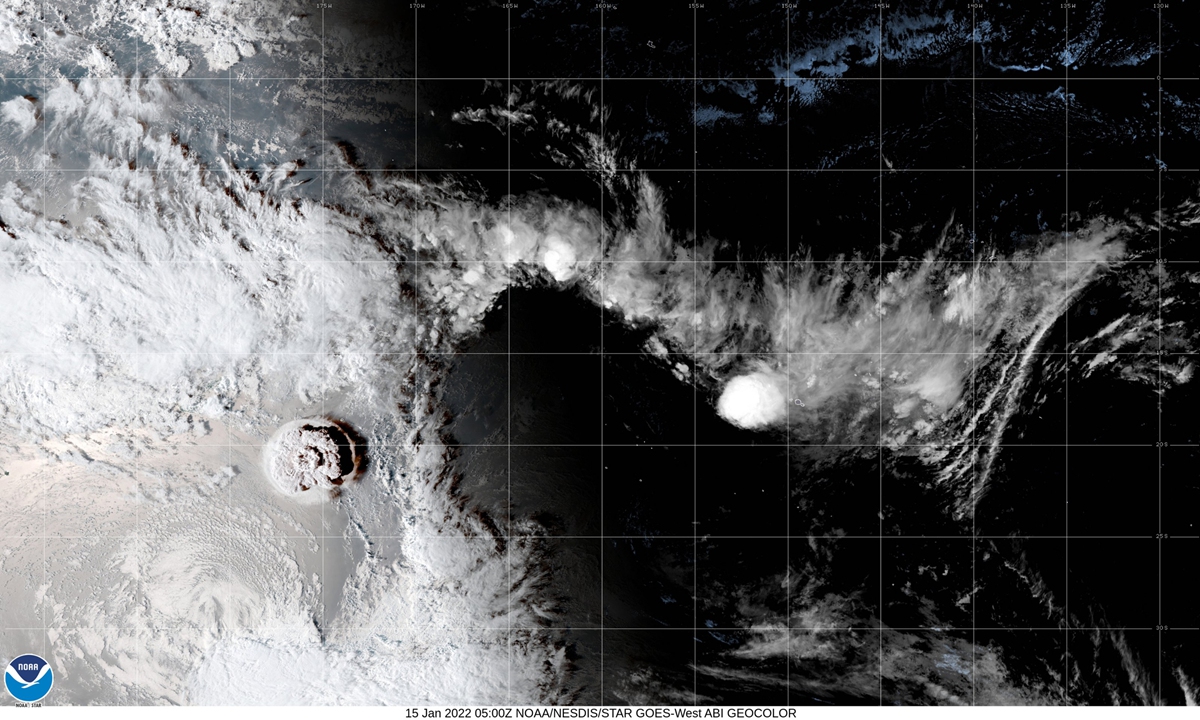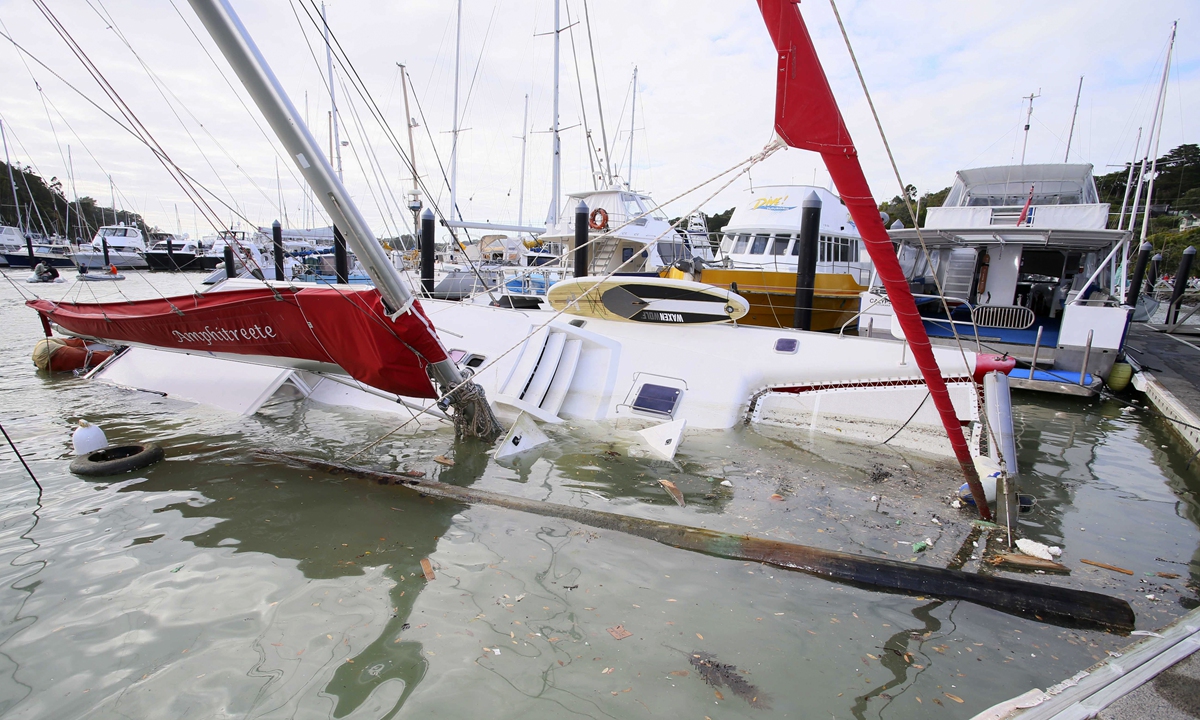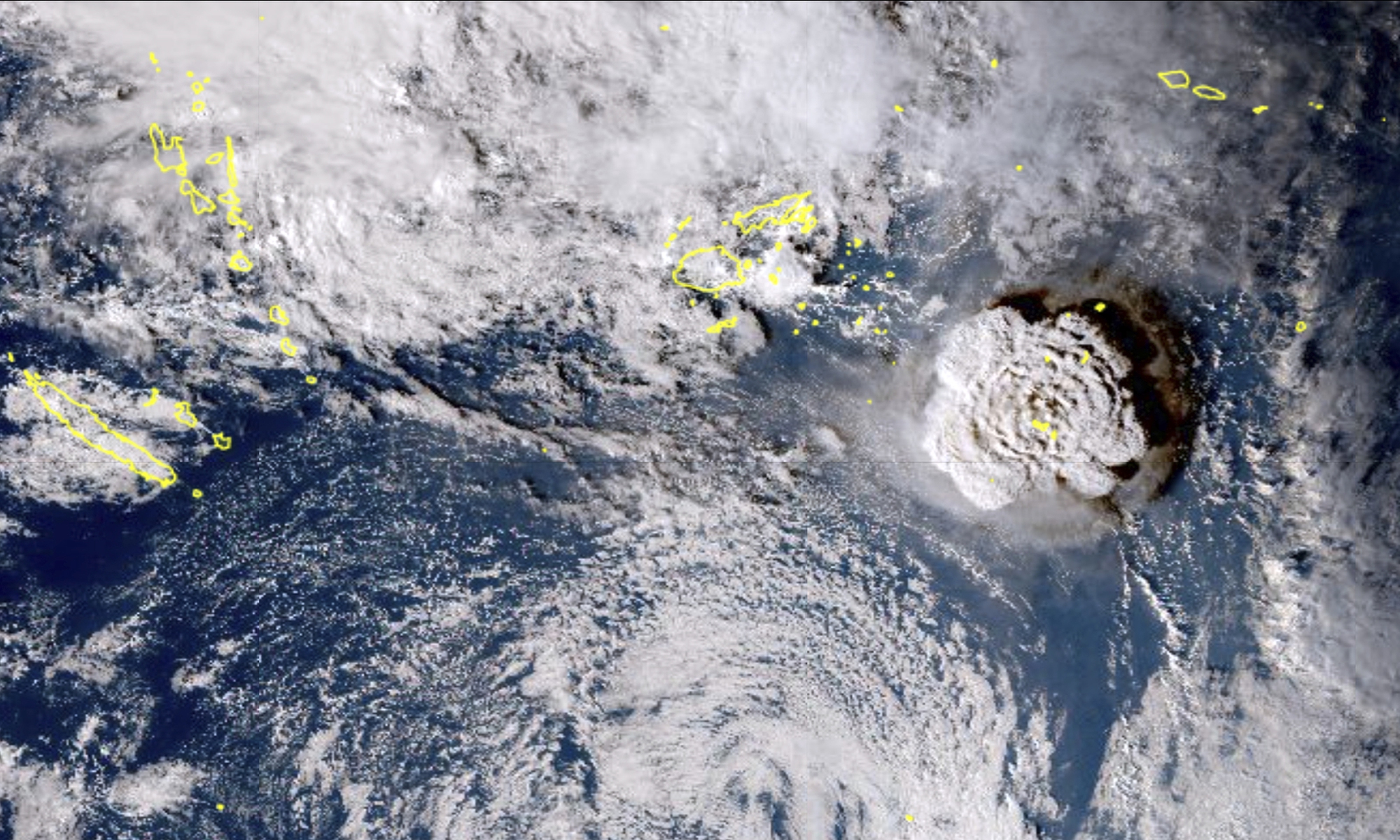
Photo:CFP

Photo:CFP

The satellite image taken by Himawari-8, a Japanese weather satellite, and released by the agency, shows an undersea volcano eruption near the Pacific nation of Tonga on January 15, 2022.Photo: VCG
No disastrous effect on China
The Tsunami Advisory Center of China's Ministry of National Resources said in a statement it sent to the Global Times on Sunday that the transoceanic tsunami triggered by the eruption of Hunga-Tonga-Hunga-Ha'apai volcano, which sits on the subduction boundary between the Pacific plate and the Indo-Australian plate, has affected the whole Pacific coastal region.
"Countries including Chile, Japan and New Zealand have monitored tsunami waves with the highest amplitude of 1.5 meters. But the waves have not brought disastrous effects on China's coast as China monitored tsunami waves earlier on Sunday with a maximum amplitude of roughly 20 centimeters detected in East China's Zhejiang Province," said the Tsunami Advisory Center.
Hunga Tonga volcano has erupted several times in recent years, including 2014, 2015, 2019 and 2021. Its eruptions have not stopped as of press time and may last for a few weeks or months, the center said.
Nie Wen, a geological disaster early warning and prevention expert with the Chinese Academy of Sciences, told the Global Times on Sunday that the possibility of continuous quakes and tsunamis cannot be ruled out.
It is very hard to carry out early warning and forecasts for volcano eruptions as they have a very short duration, and current technology would support monitoring of the process rather than early warning in a real sense, he explained.
Echoing Nie, Wang Peitao, an expert with China's Ministry of Natural Resources, said that compared to the tsunami caused by undersea earthquakes, those caused by volcanic eruptions are more difficult to predict.
China has established an early warning mechanism for tsunami caused by earthquakes that can provide early warning information 8-10 minutes before the waves hit. However, the world has yet to establish a system for tsunami linked to volcanic eruptions, Wang told the Global Times on Sunday.
Wang said the period for tsunami caused by volcano eruptions is shorter than those caused by earthquakes, but they lead to heavier damage to regions and areas adjacent to the volcano.
Expert suspect that the communication outage in Tonga may be a result of undersea cables being cut and unless foreign countries help to repair communication links, it would be hard to restore in the short term.
Amid worries about whether the disaster could completely flood the island country, Yu Lei, chief research fellow at the research center for Pacific island countries of Liaocheng University in East China's Shandong Province, believes it is unlikely to take place, as it is a relatively big country and residents would be evacuated to the higher ground.
Sharing a similar opinion, Jin Yongxing, former vice principal of Shanghai Maritime University, noted that the island country would not be flooded based on historical records of the region's volcano activities.
Tonga has experienced successive natural disasters in recent years. In 2018, more than 170 homes were destroyed and two people killed by Cyclone Gita, a Category 5 tropical storm. Two years later, in 2020, Cyclone Harold caused an estimated $111 million of damage, including extensive flooding, according to the New York Times.
Jin suggested that neighboring countries could use maritime satellites to help restore communication and locate residents.
Alert to climate change
An expert from the National Meteorological Center told the Global Times on condition of anonymity that the eruption was one of the strongest in 30 years, which could affect the global climate.
The eruption will influence the trend of La Nina through the interaction between the atmosphere and the ocean. Now the ash has begun to spread westward, which raised people's alert to the associated extreme weather such as heavy rain, the expert said. Volcanic ash can also produce acid rain.
The intensity and potential impact of a volcanic eruption is generally measured by the Volcanic Explosivity Index (VEI). Although the VEI in Tonga has not yet been determined, the size of the explosion should not be underestimated as the volcano eruption above VEI5 is generally seen as "black swan" in climate change.
The eruption of Mount Tambora on the Indonesian island of Sumbawa in April 1815 was the largest volcanic eruption in the last millennium, according to National Geographic. The Tambora immediate event killed at least 10,000 people and possibly more than 90,000, largely from exposure to the searing hot, toxic swells of gas and rock, it said. The following year, 1816, is known as the year with no summer and was marked by extreme rain and crop failures, leading to famines in the Northern Hemisphere.
The eruption of Mount Pinatubo in the Philippines in 1991 was the world's largest volcanic eruption in the past 100 years. More than 840 people were killed, with most of the deaths and injuries from the collapse of roofs under wet heavy ash, according to United States Geological Survey.
While scientists do not know if the Tonga eruption would increase the chances of extreme weather in the Northern Hemisphere, analysts warned that a serious of strong volcanic explosions may bring high risks and alter the climate trajectory in the 21st century.



